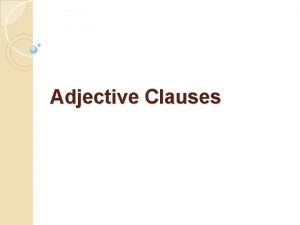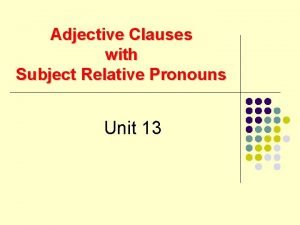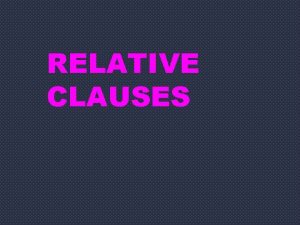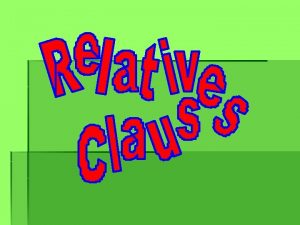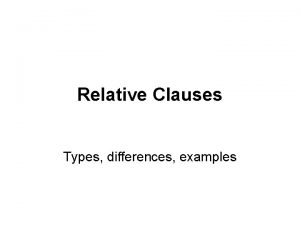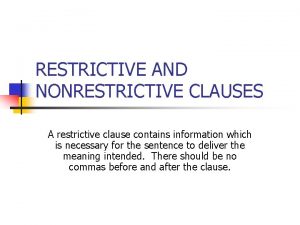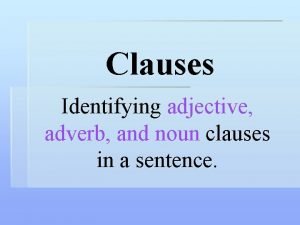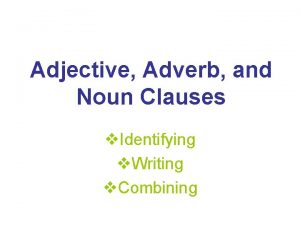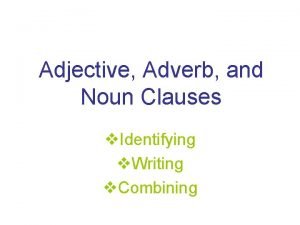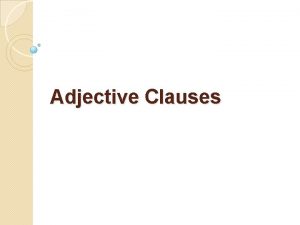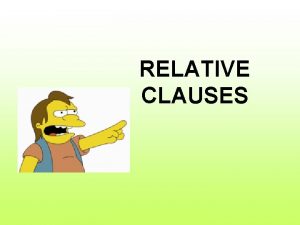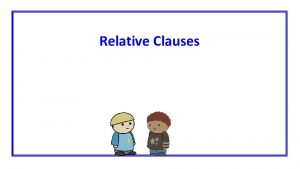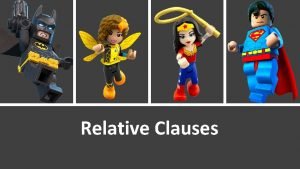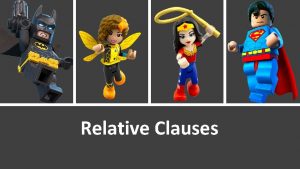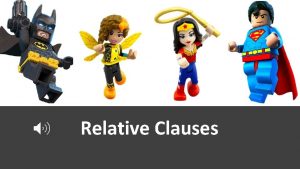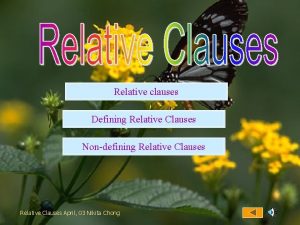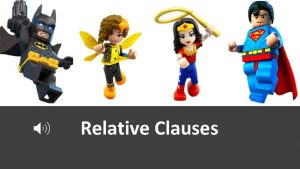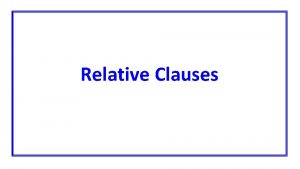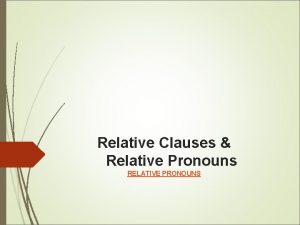RELATIVE CLAUSES ADJECTIVE CLAUSES USE AND TYPES Relative

















- Slides: 17

RELATIVE CLAUSES ADJECTIVE CLAUSES

USE AND TYPES • Relative clauses are also called adjective clauses because they define a noun as an adjective would do. • For example : • Yesterday , I saw Sarah • Who is Sarah? • Sarah is the girl (who lives next to me) this is the relative clause. It explains us who are we talking about. It restricts the meaning of the

USES AND TYPES II • Of the noun that comes before. That noun is called Antecedent. • The relative clauses that restrict or define the previous noun are called Defining ( in Spanish , Especificativas) and they are essential for the sentence meaning: • The man (who won the Nobel Prize) was Dutch

DEFINING • Who won the Nobe prize is the relative clause and defines which man are we talking about. DEFINING RELATIVE CLAUSES. -Characteristics : 1º- They are essential for the meaning of the sentence. 2º - They can be introduced by the following pronouns and adverbs :

Defining –Relative Pronouns and Adverbs • Who /that : is used when the antecedent refers to a noun. • Whom : it also refers to a noun but it always function as a complement. It is very formal and most of the times is substituted by who. e. g. The man to whom I talked yesterday is my nephew. In this case is much more common to use who and put the preposition at the end of the relative clause

DEFINING • E. g. The man who I talked to is my nephew • Which/ That is used when the antecedent refers to things or animals. e. g. : The plant (which you watered) yesterday is a cactus. The dog which was abandoned was a puppy. . Whose : cuyo, cuya , cuyos , cuyas in Spanish.

RELATIVE PRONOUNS • Whose is a possessive relative pronoun because substitutes to a possessive. e. g. The woman is devastated. Her child died in the accident. The woman whose child died in the accident is devastated. (cuyo hijo) - When : relative adverb. Refers to time That was the year when he died.

DEFINING • WHERE Straford-Upon-Avan is the city where Shakespare was born - THAT can be used instead of who or which in defining relative clauses but it is very informal 3º In defining relative clauses the relatives (who, which or that, can be omitted if it is followed by a noun or personal pronoun because in these cases that noun or personal pronouns are the subjects of the sentence. :

OMISSION • For example The man ( who you saw the other day) got the job. As the relative WHO is followed by a personal pronoun we can omit it. The man you saw the other day got the job. The same happens with which or that they

WHEN TO OMIT THE RELATIVE • Can be omitted if followed by a noun or personal pronoun: • The notebook which /that Mary bought is very expensive. • So we omit it : the notebook Mary bought is very expensive. However if this doesn’t happen it cannot be omitted

OMISSION OF THE RELATIVE • E. g. : The man ( who lives upstairs) is Canadian. (subject) Here Who cannot be omitted because it is not followed by a noun or personal pronoun but by a verb. Here WHO is the subject of the sentence and in that case cannot be omitted. 4º Relative + preposition : In defining relative clauses when a relative goes

RELATIVE + PREPOSITION • With a preposition , usually the relative is omitted and the preposition is placed at the end of the relative clause. e. g. . The girl with whom/who I’m sharing my flat has been in Spain for a year. In this case it is much common to say: The girl I’m sharing my flat WITH has been…

RELATIVE + PREPOSITION • The relative has been omitted and WITH takes a final position in its clause. • Another example : • The topic about which you were talking is very interesting. We have to omit the relative and place WHICH at the end of its clause The topic you were talking ABOUT is very …

PLACES + WHERE OR WHICH • If we want to translate the sentence: La ciudad en la que vivo You can use : the city where I live Or The city which I live in. In the last case which is omitted but not the preposition: the city I live in.

NON-DEFINING RELATIVE CLAUSES • NON-DEFINING CHARACTERISTICS : - They don’t restrict or define the antecedent but give additional information about it. - The relatives who or which can never be omitted. - THAT can never be used. - They usually go between commas.

NON-DEFINING • Madrid , which is the capital of Spain, is very polluted. • Note: remember in Defining only WHO-WHICH -THAT nor the others can be omitted if followed by a noun!!

LINKING SENTENCES • One of the uses of relative pronouns is to link sentences to avoid repetitions. • Remember the relative pronoun cannot be separated from its antecedent , that is the noun it refers to.
 Relative clause examples with answers
Relative clause examples with answers Reduction of adjective clause
Reduction of adjective clause Using adjective clauses to modify pronouns
Using adjective clauses to modify pronouns Adjective clauses with object relative pronouns
Adjective clauses with object relative pronouns Stage 15 relative clauses and relative pronouns
Stage 15 relative clauses and relative pronouns The person who phoned me last night is my teacher
The person who phoned me last night is my teacher Defining relative clauses.
Defining relative clauses. Different types of relative clauses
Different types of relative clauses Relative clause with extra information
Relative clause with extra information Relative clauses types
Relative clauses types Normal and strong adjectives
Normal and strong adjectives Non restrictive relative clause
Non restrictive relative clause Adjective adverb and noun clauses
Adjective adverb and noun clauses Non restrictive clause
Non restrictive clause Restrictive and nonrestrictive adjective clauses
Restrictive and nonrestrictive adjective clauses Adjective noun adverb clause
Adjective noun adverb clause A(n) __________ clause modifies nouns.
A(n) __________ clause modifies nouns. Difference between noun clause and adjective clause
Difference between noun clause and adjective clause


